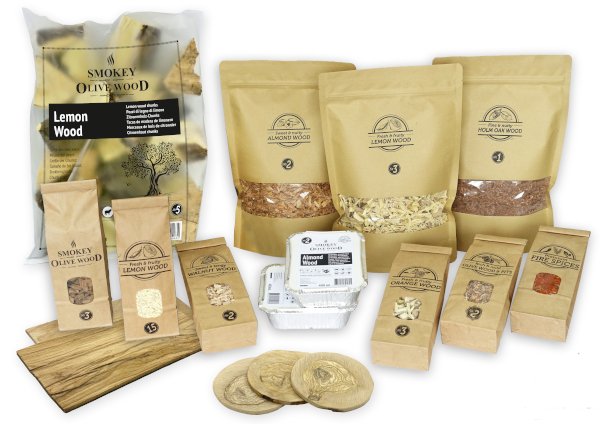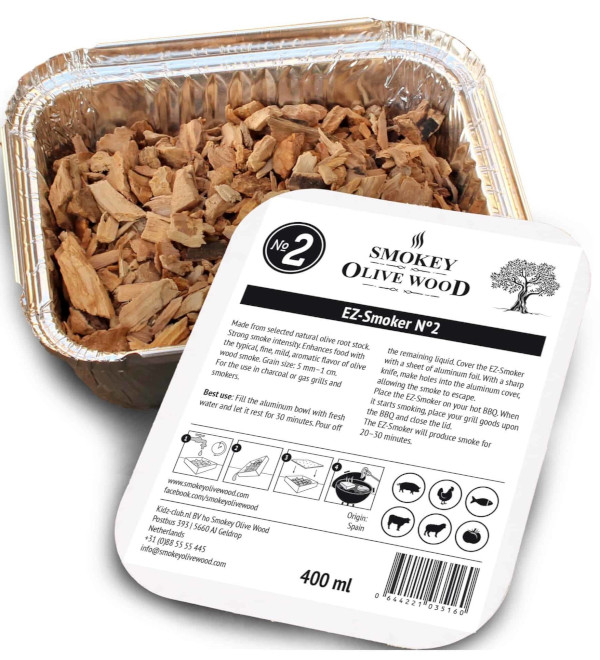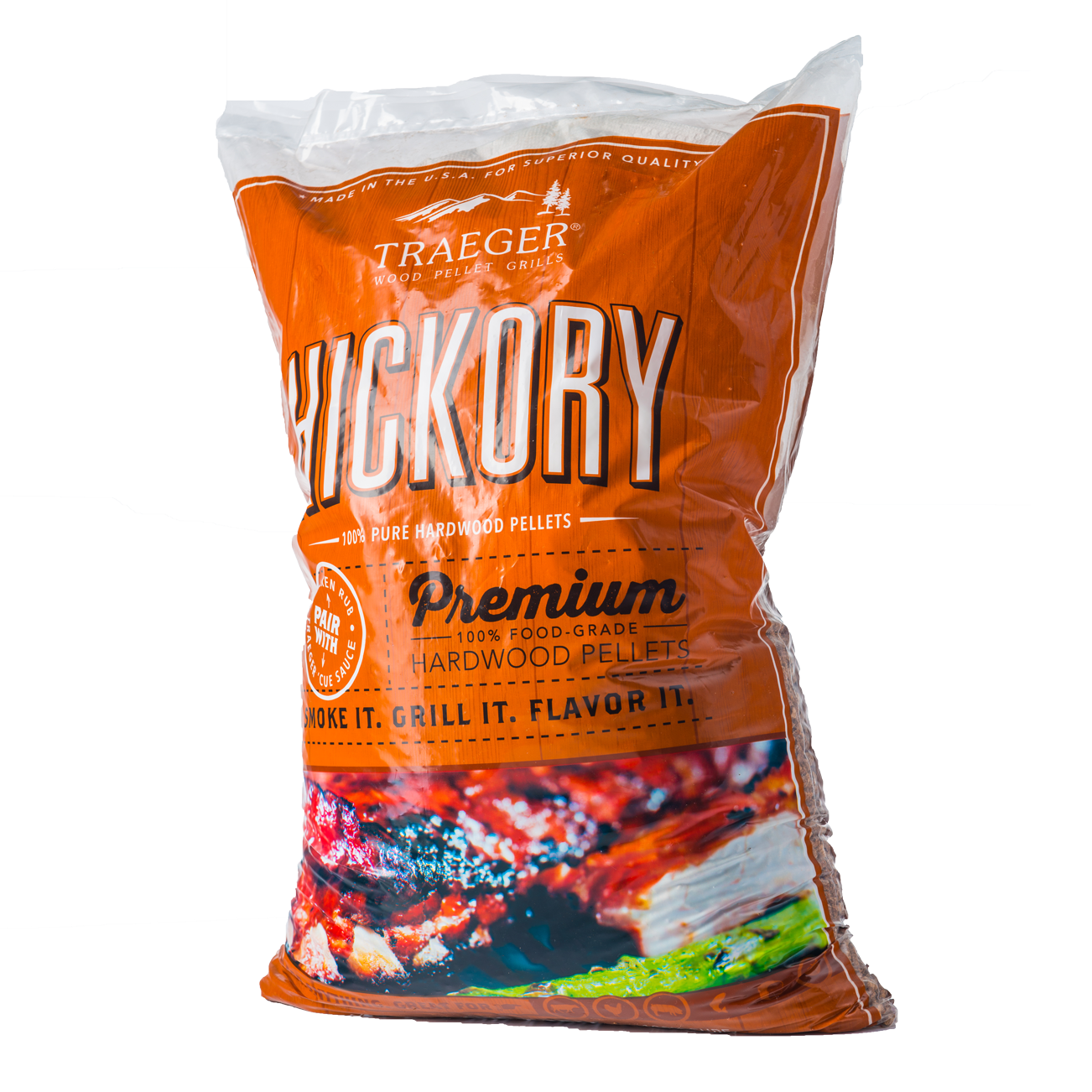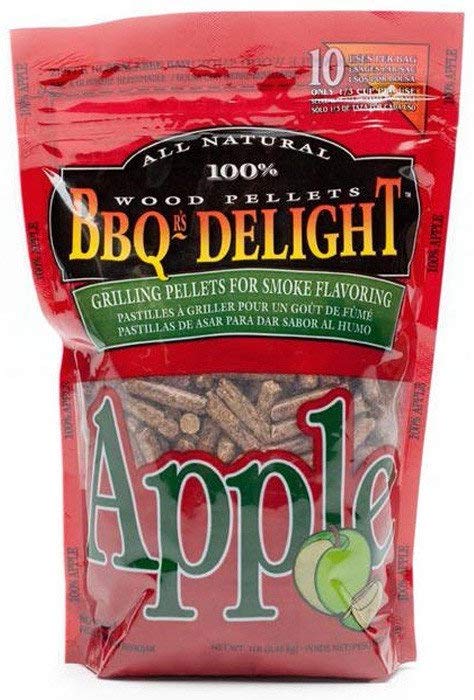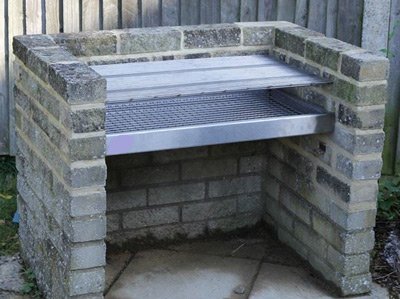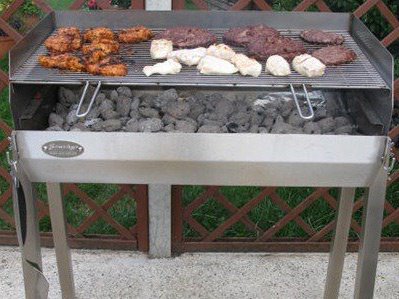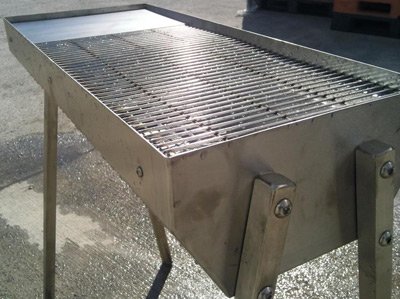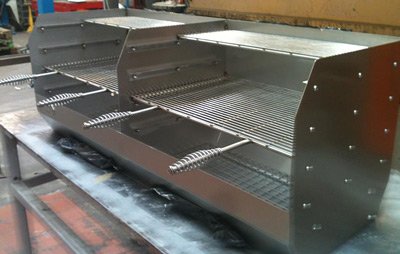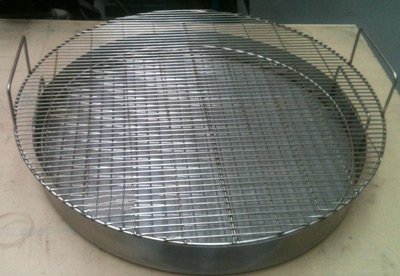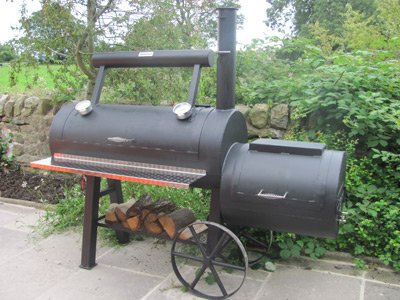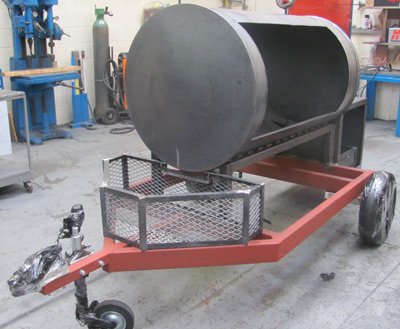- Recipes Home
- Wood Chips, Chunks & Dust
Barbecue Wood Chips, Chunks, Dust & Pellets
This page is all about barbecue wood chips, chunks, dust and pellets, how each type can be used and which factors will directly affect the flavour of the end result.
We are biologically triggered to respond to the aroma of meat being cooked over wood writes Richard Wrangham in his 2009 book Catching Fire: How Cooking Made Us Human. The Harvard biological anthropologist postulates that cooked food helped us evolve because it took less time to digest, leaving more time for us to do other things.
Traditionally cooked food would have been prepared over a wood fire
and you can still do that but these days most of us have refined our approach
by using and barbecue, grill or smoker. And the smokey flavour? Rather than it being a bi-product of the necessary heat source, we now choose to add smokey flavour to our food with barbecue wood chips or chunks.
Here I investigate the flavour impact of barbecue wood chips and chunks on the food that you serve up from your grill or smoker together with dusts for cold smoking and you may be surprised by some of the things that I reveal...it's more than just flavour and aroma.
Smoke is technically an aroma and not a flavour because it doesn’t actually penetrate the surface of the food (although some would argue that it should be considered the sixth taste after salt, sweet, bitter, sour & umami). This might seem a strange thing to say but think about the eating experience, it involves four senses; sight, taste, smell and touch so it's easy to understand how we might get confused.
Liquid smoke highlights the point about aroma vs flavour. To me, the addition of liquid smoke to food adds a flavour and is a completely different sensation to food which has been cooked over wood smoke which has an aroma.
For the purposes of this article I probably will interchange between flavour and aroma – at the end of the day, you know what I mean, right?
Do I Use Barbecue Wood Chips, Dust, Chunks Or Pellets?
Size matters! It’s the cutting of the wood that provides these different sizes. Chunks are effectively cut to size whereas chips and dust are gradings of the bi-product of the cutting process.
Understanding how and when to use wood in its different sizes will potentially reap far greater rewards than memorizing the list of which species of wood work well with which meats.
Dust
Dust is generally used for cold smoking in conjunction with a cold smoke generator. The dust is ignited and aided by an air draft, it smoulders over a long period of time. The smouldering dust emits little heat and therefore has minimal impact over the temperature in the smoking chamber which when cold smoking must not exceed 29°C (85°F).
Chips
Barbecue wood chips may be added to either a charcoal or gas barbecue to add flavour to short cooks.
For gas grills, wrap the barbecue wood chips in foil. You can either leave the ends of the wrap open or use a knife to puncture some holes in your foil parcel. Place the parcel over the burner, wait for the smoke and when it starts to appear, it’s time to start cooking.
With a charcoal barbecue you can simply sprinkle the wood chips over the lit coals and you can always add more during the cook as necessary.
Note: If you want something ready done then you'll find some manufacturers of barbecue wood chips make trays like this one below.
Chunks
Wood chunks burn for longer and are recommended for longer cooks. Used with charcoal smokers and grills, they can be placed directly onto the coals or on the cooking grate directly over the heat source.
I put chunks
around the edge of my Monolith kamado when cooking indirectly – the heat
deflector stones protect my food from direct heat but the small gap between the
stones and the fire ring give off enough heat to smoulder a chunk or two.
Pellets
Usually made from sawdust, pellets are manufactured by forcing the dried sawdust through a die at high pressure. This causes the sawdust to heat up and release the natural lignins in the wood that bind the sawdust together to form the pellet. The benefit of the pellet is that it shows consistent quality thanks to the highly controlled manufacturing process.
There are two types of barbecue wood pellet:
- Wood pellets for a pellet grill / smoker (Traeger, Green Mountain Grills, Grillson etc. The pellets usually come in large 20lb (9.07Kg) bags and generally are made up of 40% flavoured wood and 60% oak. There may also be a bark content in there because this helps with burn length.
- Pure flavoured wood pellets. Small 1lb (450g) bags of pellets made from the pure wood sawdust. These are designed to be used just like barbecue wood chips and the aromas generated are certainly more distinct than the diluted versions made for wood pellet grills. Two bags will cost you more than one big bag of pellet grill pellets so you can't economically use pure wood pellets in a pellet grill.
I did a an experiment to see how long different brands of wood pellet performed in a pellet smoker and frankly I found very little difference in either looks, size, thermal performance or ash creation. To be honest, they could have been the same pellet in a different bag but I don't know for sure.
This guide is still relevant to pure wood pellets (use like barbecue wood chips) but because they are manufactured in a highly controlled environment you're tied to buying what's available. There may however be subtle differences between one pellet brand and another.
How Do Barbecue Wood Chips Affect Smokey Flavour?
Wood smoke is a complicated concoction of over 100
different compounds. Some of
these compounds exist as solids, some as gases and others as oils.
The exact makeup of the smoke you make on your barbecue will depend on the temperature of combustion, the amount of available oxygen, the humidity and the species of wood you have used.
The wood cell wall is composed of micro-fibrils of cellulose (40 to 50%) and hemicellulose (15 to 25%) impregnated with lignin (15 to 30%). Lignin is the substance that gives wood its compressive strength and put simply, the higher the lignin content the hotter the burn temperature.
Two flavour significant gases are the phenols syringol and guiacol. These gases are only present in trace amounts, but they pack a punch when it comes to the classic barbecue smell and flavour.
How Do These Compounds Deliver Great BBQ?
Below you'll find out about the sensory outcomes that we notice in barbecue food and which compounds contribute to that outcome.
Colour
Carbonyls derived from cellulose and hemicellulose react with high protein foods to add colour.
Nitrogen dioxide and carbon monoxide react with myoglobin in meat to form the smoke ring. Moisture on meat facilitates this reaction.
Flavour / Aroma
Phenols from lignin adhere to the food surface and then diffuse into the food delivering spicy notes such as clove, peat, vanilla.
Carbonyls from cellulose and hemicellulose do the same adding sweet, nutty, flowery notes.
Texture
Formaldehyde and creosote derived from cellulose and hemicellulose alter the protein structure and contribute to the formation of the bark.
Note: Smoking for too long can toughen meat.
Preservation
Antioxidants from Lignin react with lipids (fats). Formaldehyde and acids (from cellulose and hemicellulose) coat the surface of the food, lower the pH and therefore slow bacterial growth.
Note: Wet wood inhibits a lot of this preservation process. It can also impart excessive formaldehyde and acids which deliver an acrid flavour and worse still can be considered a health risk.
Other Factors Affecting Smoke / Aroma
Hydration Of The Wood
It’s always best to use dried wood because wet wood will affect burn temperature and it can also lead to excessive formaldehyde deposits and acrid flavour as stated above.
Newly cut (green wood) can hold upwards of 50% moisture and this will affect burn temperature. The ideal hydration of wood needs to be below 25% and above 5% and this is best achieved by dry storage for a minimum of one year.
Wood stored in damp conditions also risks being contaminated with mold. There could be toxins in the mold that will adversely affect flavour or worse still, make you ill.
Soaking Barbecue Wood Chips
If you want to, then why not. Soaking barbecue wood chips overnight will add some moisture to the chips and this will slow down the burn time. It’s not worth soaking chunks because the surface area to volume ratio means that they really soak up very little extra moisture.
That said, only consider burn time when hot smoking. Any additional moisture when cold smoking is only going to slow down the drying time and is therefore counter-productive.
If you prefer to soak wood chips and have forgotten then don't hold up the barbecue! You can get around this next time by soaking a load of chips, put small quantities into foil envelopes and then store in the freezer. Next time you need a parcel they're ready to use.
Note: If using pellets as an alternative to barbecue wood chips then don't soak them because they just turn to mush. Similarly, don't try to soak wood dust!
Burn Temperature Of The Wood
Ideal is between 300 – 400°C. Higher than this and you
risk an acrid smell contaminating your food.
Conversely a low burn temperature reduces the impact of the antioxidant reaction with the lipids (fats) risking early rancidity. This is important for cold smoking where presevation is more important.
Look at the wood species list below, a wood with medium burn temperature that will burn slowly and steadily is preferable for cold smoking.
Species Of Wood
Hardwood chips are now readily available in most stores where barbecues are sold and some of the popular varieties packaged by the BBQ brands include hickory, maple, mesquite, oak, apple or cherry. But there's so much more to try; all citrus woods are good as are most fruit or nut bearing hardwoods.
Different woods have different compositions of the base compounds that create the aroma so by definition there will be subtle differences in the gases effused and therefore the aroma. Just as with winemaking, the same species of wood will have a slightly different flavour profile dependent on the soil composition where it has been grown. That said I think that these flavour nuances are hard to detect (especially when you've got a rub and/or a sauce to contend with) and some of the points addressed above have a bigger impact on smoke flavour.
There are a lot of tables on the internet that claim certain species of wood are recommended with certain meats. To be honest I think a lot of these tables owe much to the wood chip manufacturers’ marketing team and other websites that just copy and paste the same garbage.
I’m not going to recommend a pairing meat, I'll simply give you my experience of using it and any other information that is relevant to making a choice or confirming that what you have available is is suitable or not. I’ll then also talk about the woods to avoid.
After that, just choose a wood, find the barbecue wood chips that work for you and stick to them. Hone your barbecue skills and then you can start to play around with the different varieties of barbecue wood chips.
Here's The Full Smoker and Barbecue Wood Chips Flavor Guide
Acacia
Part of the Mesquite family provides strong smoke although lighter than Mesquite. It burns at a high temperature and I prefer to use it on an open grill rather than for smoking...and I use it sparingly.
Alder
A mild smoke with a delicate aroma with a hint of sweetness. Traditional in the North West of USA, it is also a classic Scandinavian choice for cold smoking.
Almond
One of my personal favourites. Nutty, buttery and sweet smoke flavor that’s good for pretty much everything. It's quite light and I for that reason I use it when cooking veggies.
Apple
Delicately sweet with a dense fruity smoke flavour very similar to Cherry. I find it to be a great all rounder, infact I haven't found anything yet that doesn't go with Apple wood. It's a high temperature burn with good longevity. Note how these barbecue wood chips give a dark colour to chicken skin.
Apricot
It's a fruit wood so you really can't go wrong. Apricot barbecue wood chips are not abundantly available commercially but if you can get hold of any then try them.
Ash
Be warned this one burns hot and fast with a light but distinctive smoke. I tend to use on fairly short smokes like a chicken.
Beech
Common in Germany for smoking Bratwurst. It's mild in flavour and quite sweet, I like to use it blended with oak where it just takes the edge off the strong oak.
Birch
A medium hardwood. Laplanders almost exclusively use birch for cold smoking fish. If hot smoking make sure that there's no bark in there because this will deposit a bitter tar on your food.
Blackthorn
A member of the rose family and a fruit wood so it's good for smoking. The fruit are called sloes
Butternut
A strong smoke like Walnut so use it sparingly. Use on red meats and game because it will overpower white meat. Rather than use it exclusively I tend to blend it with another wood.
Cherry
Sweet fruity smoke flavour and another great all rounder although it doesn't burn quite as hot as Apple. Another wood that gives a dark colour to chicken skin (and darker still than Apple).
Chestnut
Is it too cheesey to say that it's got a nuttiness to the smoke? Perfectly good all-rounder and slightly stronger than most fruitwoods.
Cottonwood
Being European this wood isn't readily available to me. It's in the list because it's perfectly good to use but I understand it to be a very mild smoke.
Damson
Damson is a good all round for smoking and is sweet and mild. Damson Is very verstile as a smoke wood, it can
be succesfully mixed with other citrus woods.
Elm
I've seen a lot of writing saying don't use Elm. Contrary to what's written, Elm is safe to use, that said there's no wow factor so I don't go out of my way to find it.
Fig
I tried this over an open fire in Italy and it wasn't overpowering at all. Recommended.
Grape Vine
Aromatic but quite tart. Loved by Californians (apparently)! Burns with a heavy smoke so best suited to open fire cooking.
Grapefruit
Medium smoke with a hint of fruit. Not readily available where I come from but if you can get, use it.
Hazlenut
A sweet fresh aroma. Not easy to get hold of but worth a try.
Hawthorn
Very similar to Blackthorn and a good all-rounder
Hickory
Pungent smoky bacon flavor and the traditional wood for pork and ribs. Probably the most readily available and widely used of all barbecue wood chips
Holm Oak
Acorns from this Oak feed the world famous Iberico pigs (Jamón ibérico), sought after by many top chefs. The good news is that you can now get these barbecue wood chips commercially through the Smokey Olive Wood Company. Do not confuse with Spanish Oak.
Lemon
Another great fruit wood traditionally used for open fire cooking in Spain. Lemon barbecue wood chips are my favourites for white meats and white fish in particular.
Lilac
Light and subtle with a floral hint, medium smoke.
Manuka
A member of the Myrtle family, Manuka is known for its antibacterial
and fungicidal properties although I can't say whether any of this transfers into the barbecue wood smoke. Manuka brings the rich, mellow flavours of New Zealand to your smoker or barbecue.
Maple
Mild smoke, slightly sweet. I like it with fish.
Mesquite
Some love it (Texans) and some hate it. Strong and earthy from Cajun origins, I prefer to use it on an open grill than in my smoker.
Mulberry
Beautifully sweet apple flavor delightful with beef, poultry, game, pork and ham
Nectarine
Similar to hickory but sweeter and quite mild but good for most meat
Oak
Really heavy smoke. Since Holm Oak has arrived on the scene, my use of English Oak has pretty much died a death.
Olive
Quite pungent which means that a little goes a long way. Some would describe as a mild Mesquite but I think it much more subtle. I like to use it on an open charcoal fire and bring back happy memories of the Mediterranean.
Orange
Medium smoke with a light fruit hint for pretty much everything. Turns food a beautiful golden colour. If you've never done cold smoked salmon with Orange dust then you haven't lived!
Peach
Slight sweet flavor suitable for most meat
Pear
Another one with a slightly sweet flavor and this time good for poultry, game and pork
Pecan
Similar to Almond. Mild nutty smoke and great with the vegetables.
Persimmon
An excellent alrounder with a fairly mild smoke.
Pimento
As you would guess, Pimento pairs well with spicy dishes. Cut from the Pimento or
Allspice tree they provide a rich and complex smoke flavour.
Plum
Similar to hickory but milder and sweeter, another one suitable for most meat.
Tangerine
Use like any other citrus wood.
Walnut
Very heavy smoke and can be bitter so best blended with a fruit wood. Good with strong flavored red meat and game.
Willow
Great for cold smoking but it didn't do anything for me as a hot smoking wood
Other options for adding flavour include
- Dry twigs from fruit trees or vine cuttings
- Woody stalks from herbs such as rosemary, thyme or bay
- Leftover almond, walnut or hazelnut shells that have been soaked for 30 minutes in water
- Seaweed (when cooking fish or seafood) - make sure it's washed
- Dry corn cobs
Woods To Avoid
Avoid softwoods. You may have deduced this when reading through our list of woods not to use. Softwoods are not a good idea because they are sappy, and contain terpenes. These can leave your meat tasting odd. Worse still, some people feel ill after eating meat smoked using these kinds of wood.
Resinous woods do however add colour and I know some who will add a very small quantitiy of softwood sawdust (or Juniper sprigs) to their hardwood when cold smoking just to add a hue of colour. That said, they also leave a resinous couting on the inside of your smoker!
It would be impossible to write a list of all the woods that cannot smoke with so if in doubt, stick to the list above and you won't go wrong.
See Also:-
More BBQ Accessories and Gift Ideas
Barbeque Smoker Information
Information About BBQ Grills

Return to Home from Smoker And Barbecue Wood Chips Flavor Guide
